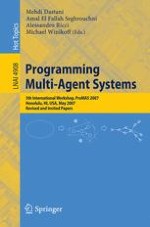2008 | Book
Programming Multi-Agent Systems
5th International Workshop, ProMAS 2007 Honolulu, HI, USA, May 15, 2007 Revised and Invited Papers
Editors: Mehdi Dastani, Amal El Fallah Seghrouchni, Alessandro Ricci, Michael Winikoff
Publisher: Springer Berlin Heidelberg
Book Series : Lecture Notes in Computer Science
